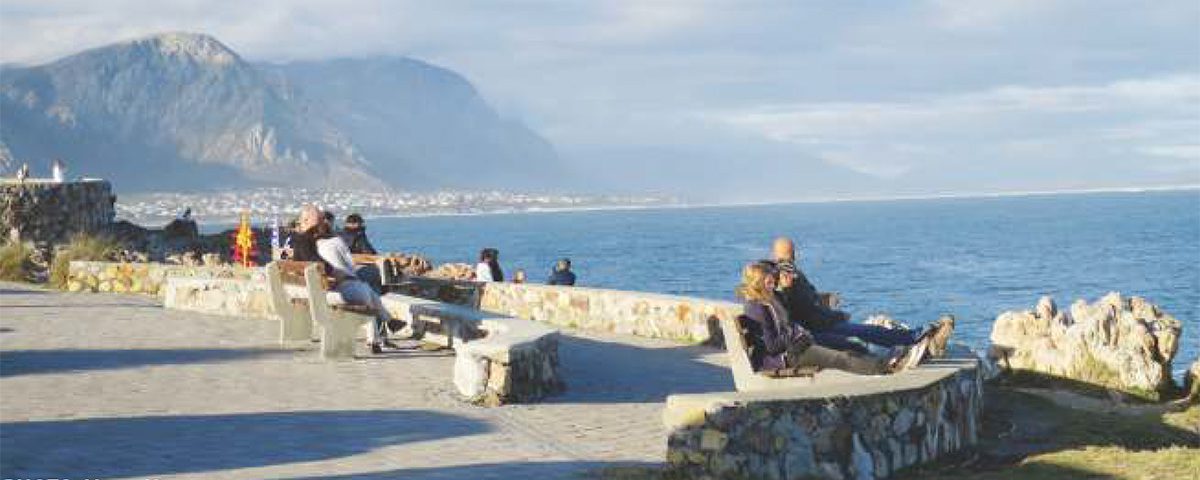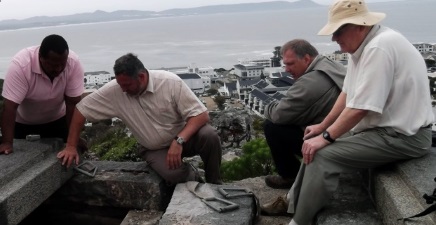
Meeting on 20 August 2017
August 28, 2017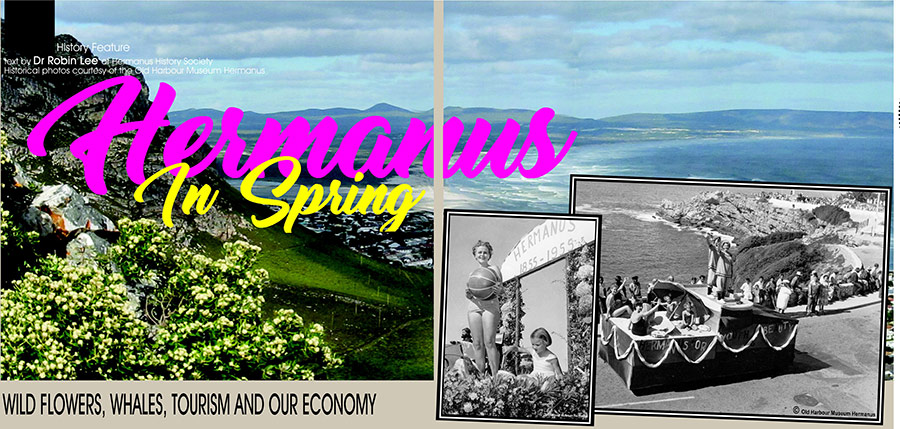
Hermanus in Spring: Wild Flowers, Whales Tourism and Our Economy
September 6, 2017Gearing’s Point is one of the centrally located historic sites in Hermanus, situated on the western side of the Old Harbour, with vehicle and pedestrian entrance from Marine Drive. DR ROBIN LEE of the Hermanus History Society did some research on this well-known landmark, which was named after Mr Sydney Charles Gearing (1856-1924) or, more likely, informally refers to the entire Gearing family.
The Gearing family holidayed in Hermanus for several years in the late 19th and early 20th centuries, staying in a cottage near the Old Harbour, then known as Visbaai. In 1912, Gearing bought a square, stone-walled, thatched house on a plot that had originally belonged to Henn, one of the founding families of Hermanus.This is most probably the property that still stands at 71-73 Marine Drive, though more research is needed to have this confirmed in the Deeds Office in Cape Town. This building has been classified as a 3A heritage building, which means that no alterations are permitted in respect of the outside of the house. In 2017 it is of course in a prime position and is currently on the market.
This is most probably the property that still stands at 71-73 Marine Drive, though more research is needed to have this confirmed in the Deeds Office in Cape Town. This building has been classified as a 3A heritage building, which means that no alterations are permitted in respect of the outside of the house. In 2017 it is of course in a prime position and is currently on the market.The formal naming of the headland, which provides some shelter from the open sea on the west side of the Old Harbour, came long after it appears, unnamed, in Hermanus history. Traditionally, the wives and families of fishermen would gather at the ‘point’ to watch out for the returning boats. Usually, this resulted in an early sight of laden boats on a relatively calm sea, and the relieved watchers then moved to the Old Harbour itself to assist with cleaning the catch once it was landed.
The formal naming of the headland, which provides some shelter from the open sea on the west side of the Old Harbour, came long after it appears, unnamed, in Hermanus history. Traditionally, the wives and families of fishermen would gather at the ‘point’ to watch out for the returning boats. Usually, this resulted in an early sight of laden boats on a relatively calm sea, and the relieved watchers then moved to the Old Harbour itself to assist with cleaning the catch once it was landed.But, not infrequently, wives and children gathered anxiously as bad weather or a serious storm was raging or approaching. Then fears ran high and shouts and cries were heard if one or other of the boats seemed to be damaged or could not be seen at all. There is no record of fishermen’s lives lost in Hermanus, but it occurred often enough to be in the townspeople’s minds every time the boats went out.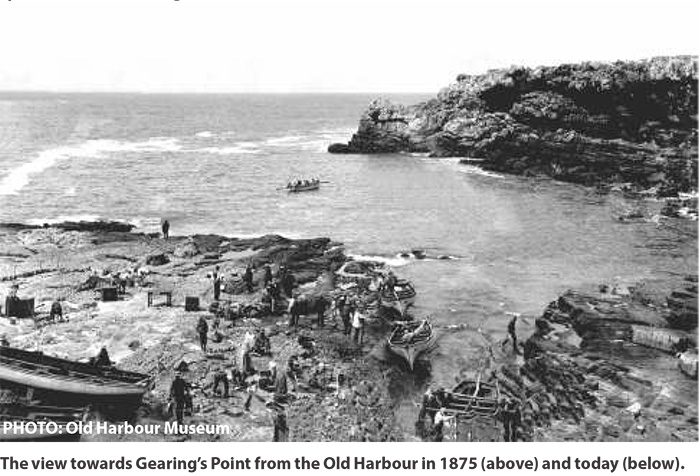
But, not infrequently, wives and children gathered anxiously as bad weather or a serious storm was raging or approaching. Then fears ran high and shouts and cries were heard if one or other of the boats seemed to be damaged or could not be seen at all. There is no record of fishermen’s lives lost in Hermanus, but it occurred often enough to be in the townspeople’s minds every time the boats went out.As the fishing activity declined during the 20th century the image of anxious women and children watching from the very edge of Gearing’s Point has faded and it requires a real act of imagination to see them now, watching for the return of husband and father.
As the fishing activity declined during the 20th century the image of anxious women and children watching from the very edge of Gearing’s Point has faded and it requires a real act of imagination to see them now, watching for the return of husband and father.Sydney Gearing himself was a prosperous businessman in Cape Town. Biographical records are hard to find, but he appears to have owned a business known as Cunningham and Gearing, which had been situated since 1876 in Ebenezer Road, close to Cape Town Harbour. Today, the fashionable Beluga Restaurant is on the site.
Sydney Gearing himself was a prosperous businessman in Cape Town. Biographical records are hard to find, but he appears to have owned a business known as Cunningham and Gearing, which had been situated since 1876 in Ebenezer Road, close to Cape Town Harbour. Today, the fashionable Beluga Restaurant is on the site. A history of the firm has been written and in it the nature of the business is described: “They did ship repair work, made agricultural machinery and also made wind pumps. The Gearing’s wind pump was well-known and some are still in existence.” The Gearing family lived in Rondebosch and according to one account, Gearing was once Mayor of Rondebosch, which was then an independent municipality.
A history of the firm has been written and in it the nature of the business is described: “They did ship repair work, made agricultural machinery and also made wind pumps. The Gearing’s wind pump was well-known and some are still in existence.” The Gearing family lived in Rondebosch and according to one account, Gearing was once Mayor of Rondebosch, which was then an independent municipality.By the start of the 20th century, Hermanus had been a holiday destination for decades but even then was not an easy place to reach. In her charming history of Hermanus, Arderne Tredgold records what is undeniably one of the most evocative accounts of a journey to Hermanus at that time:
By the start of the 20th century, Hermanus had been a holiday destination for decades but even then was not an easy place to reach. In her charming history of Hermanus, Arderne Tredgold 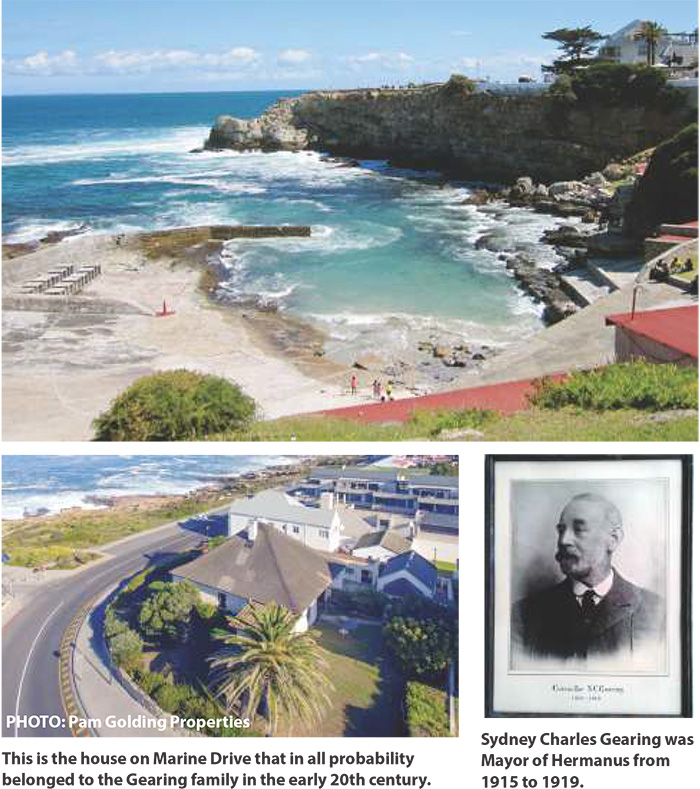 records what is undeniably one of the most evocative accounts of a journey to Hermanus at that time:(Sydney Gearing’s) daughter, Mrs. O M Grant-Dalton, described to me the journey they made to Hermanus in 1900. First, Mr. Gearing had to obtain a permit to travel out of Cape Town because it was the time of the South African War, then Mrs. Gearing had to make preparations for a family of eight.
records what is undeniably one of the most evocative accounts of a journey to Hermanus at that time:(Sydney Gearing’s) daughter, Mrs. O M Grant-Dalton, described to me the journey they made to Hermanus in 1900. First, Mr. Gearing had to obtain a permit to travel out of Cape Town because it was the time of the South African War, then Mrs. Gearing had to make preparations for a family of eight.
(Sydney Gearing’s) daughter, Mrs. O M Grant-Dalton, described to me the journey they made to Hermanus in 1900. First, Mr. Gearing had to obtain a permit to travel out of Cape Town because it was the time of the South African War, then Mrs. Gearing had to make preparations for a family of eight. “That was a real undertaking for my mother. She had to think not only of clothes for a family of eight but also food – we took most of our groceries with us (the shops were primitive in Hermanus then) and also a large tin of Australian butter which was supposed to last 1 month. How far off Hermanus seemed then, a trek of two whole days. We left Rondebosch before eight o’clock in the morning and reached Sir Lowry’s Pass by train about 1 p.m.”
“That was a real undertaking for my mother. She had to think not only of clothes for a family of eight but also food – we took most of our groceries with us (the shops were primitive in Hermanus then) and also a large tin of Australian butter which was supposed to last 1 month. How far off Hermanus seemed then, a trek of two whole days. We left Rondebosch before eight o’clock in the morning and reached Sir Lowry’s Pass by train about 1 p.m.” This was the terminus. There they all packed into a covered wagon with eight mules belonging to a Mr. Erwee. Some of them walked part of the way up the pass to help the mules.
This was the terminus. There they all packed into a covered wagon with eight mules belonging to a Mr. Erwee. Some of them walked part of the way up the pass to help the mules. “We usually made camp at Grabouw on the grass by the Palmiet River for the night. We children slept under the wagon and the grown-ups inside the wagon tent. There was a canvas manger for the mules along the ‘disselboom’ and they were tethered there. We went to sleep to the sound of munching.”
“We usually made camp at Grabouw on the grass by the Palmiet River for the night. We children slept under the wagon and the grown-ups inside the wagon tent. There was a canvas manger for the mules along the ‘disselboom’ and they were tethered there. We went to sleep to the sound of munching.” When the Bot River was too full to be crossed at the usual drift
When the Bot River was too full to be crossed at the usual drift travellers had to make a long detour which brought them round to a little shop on the Hermanus side of the drift. They outspanned for lunch between Afdak and Hawston and the last part of the journey seemed very long until they reached Onrus and caught the first whiff of the famous sea air of Hermanus.
They travelled on and “at last we rumbled down the Main Street of the little fishing village in the afternoon (of the second day), the wagon wheels bouncing over the rocks especially as we turned through the rickety gate and over the grass to arrive with a flourish in front of the cottage”.
It stood on the corner of Marine Drive and Harbour Road… (and) looked out to the headland guarding the harbour and that is how the headland was given the name of Gearing’s Point.
In later years the headland provided the venue for informal gatherings and parties during the holiday season. Tredgold comments: The green grass by Gearing’s Point and where Swallow Park is, were good places for dancing and there was always someone who could give a tune on a concertina or guitar.
Maxie van Dyk will be remembered by many as she worked in Grant’s Pharmacy for decades. She also remembered the old Gearing’s Point and shared her memories with S J du Toit in 2006: Another pleasure was the annual Christmas seaside services at Gearing’s Point. The surface was grassy, but very uneven then. Maxie remembers singing ‘I will make you fishers of men’ and other songs.
Mr Gearing grew very attached to Hermanus and eventually sold the business in Cape Town and came to live permanently here. From 1915 to 1919, during the very difficult War years, he was Mayor of Hermanus.
Gearing’s Point is now formally laid out and a favourite whale watching site among tourists.
References:
1. Du Toit, S J: Hermanus Stories III 2. James, John: The History of Cunningham and Gearing Foundry 3. McAlister, Heather: The History of Rondebosch 4. Tredgold, Arderne: Village of the Sea: The Story of Hermanus
Date: 29 August – 11 September 2017

